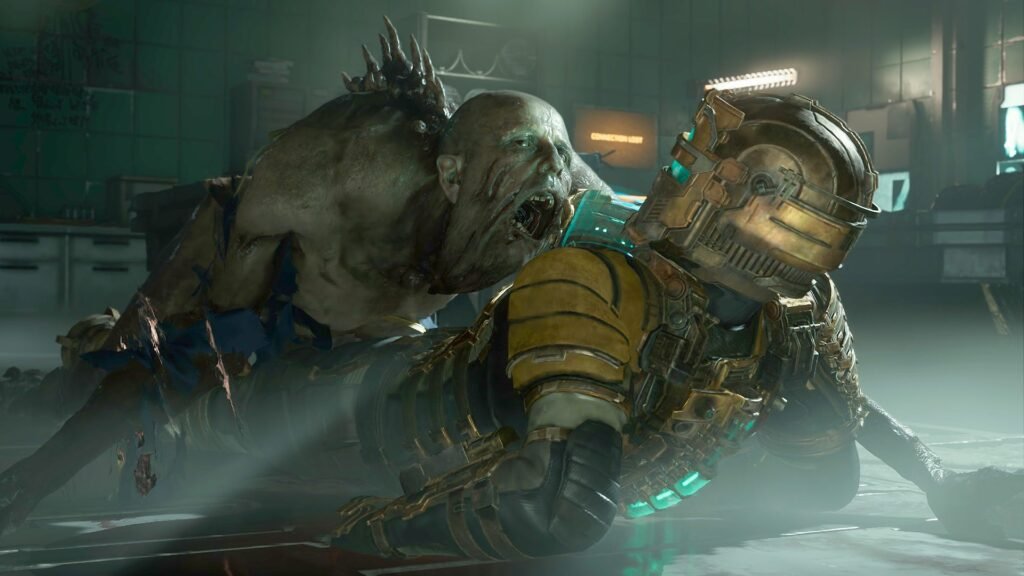
Despite the numerous necromorphs, the tortured bodies sprouting from walls, and the terrifyingly towering space sphincter, my biggest fear going into the Dead Space remake was that it wouldn’t live up to my fond memories of the original 2008 game. After spending over 12 hours navigating the revitalized USG Ishimura, I’m relieved to say that this concern was unfounded.
The new Dead Space enhances the original in nearly every way, skillfully trimming its less appealing features while preserving the essence of its dismemberment-focused gameplay. It also introduces new character details that present its eerie sci-fi horror narrative in a compelling light—along with some intimidating shadows.
For those unfamiliar, Dead Space evolves the action-oriented survival horror established by Resident Evil 4, combining gunplay with the ability to throw objects using kinesis and temporarily slow down enemies with a stasis power. Players must unlearn traditional zombie-killing tactics; instead of relying on instant headshots, they must blast limbs off the agitated mutants. Set aboard a doomed spaceship reminiscent of Event Horizon, the story follows engineer Isaac Clarke in his increasingly disturbing search for his wife, Nicole.
While the franchise has produced sequels, comics, and even a spiritual successor, nothing has matched Isaac’s heavy footsteps on the Ishimura—until now.
Developer Motive Studio has made significant renovations to this house of horrors, and I love what they’ve done. The level of detail in Isaac’s iconic engineering suit makes the original look like a cheap costume. The spaceship’s surroundings feel much more spine-chilling, with weathered steel surfaces and walls overrun with grotesque growths. The moody lighting highlights enhanced environmental details while keeping corners cloaked in shadow, maintaining suspense about what lurks within.
Not only does the Ishimura look more striking than ever, but it has also been restructured to encourage greater exploration. Players can now shuttle freely between tram stations and travel on foot through new corridors connecting different areas. A spectacular new zero-gravity section allows for more liberated flight controls, letting players manually steer Isaac through space rather than moving him in straight lines. This interconnected layout fosters a stronger sense of place and allows for backtracking to access previously locked areas, enhancing the feeling of progression akin to a murder-heavy Metroid game.
The combat remains focused on disarming and disabling the grotesque enemies instead of wasting ammo on their heads. While the enemy types resemble the original’s monstrosities, there are notable tweaks to the variety of threats you’ll encounter. The acid-vomiting variants of the basic slasher enemies are more common than I remember, keeping me on my toes even after dismembering them from a distance. Meanwhile, the hyper-mobile enemies feel more frenetic, testing both my aiming skills and my stasis reserves.

Dead Space also finds creative ways to keep tension levels high, particularly through new circuit breakers that require you to divert power to interactive elements in the environment. For instance, when I chose to power a storage room door, I had to sacrifice the lighting system, plunging me into darkness illuminated only by my plasma cutter’s beam. This made my return trip panic-inducing, with necromorphs flashing into view just out of reach.
To even the odds, the environment now features more interactive elements, such as stasis tanks that can be detonated to slow down groups of enemies. This gives players a crucial moment to decide whether to shoot or flee.
Motive Studio has kept Dead Space’s most memorable moments intact while refining weaker scenes. For example, the first encounter with a regenerating enemy retains its intense close-quarters style, while the much-maligned asteroid-blasting sequence has been completely reworked. Instead of being stuck in a gunner’s seat fending off asteroids, players now venture into space to manually calibrate the Ishimura’s defense system. This change transforms a frustrating chore into an exhilarating challenge, exemplifying the thoughtful improvements made throughout the game.
In addition to quality-of-life enhancements, weapons are now found throughout the world rather than purchased from a store. This allows players to try out all seven weapon types before settling on their favorites, creating a more engaging experience. While I gravitated toward my usual plasma cutter, line gun, and force gun combo, each felt even more enjoyable thanks to new perks like incendiary fire.
Isaac’s story has also been enriched with additional context. A new multi-part side mission involves following holographic logs that reveal more about Nicole’s last days before the necromorph outbreak, along with audio and text files that shed light on the couple’s strained relationship and the Church of Unitology’s role in Isaac’s upbringing. This deeper context enhances my understanding of Isaac’s emotional state, making the final twist more plausible.
Additionally, Isaac now speaks, which further humanizes him. Voiced by Gunner Wright, who reprised his role from the sequels, Isaac engages in discussions with Chief Security Officer Hammond, making him feel more influential. He speaks only when prompted, avoiding unnecessary quips while navigating the horror around him. His heavy breathing and heartbeat heighten the tension, reflecting his state of mind.
With its stunningly redesigned spaceship, intelligently enhanced story, and spectacularly reimagined action sequences, Motive Studio has successfully breathed new life into the iconic sci-fi horror universe of Dead Space.